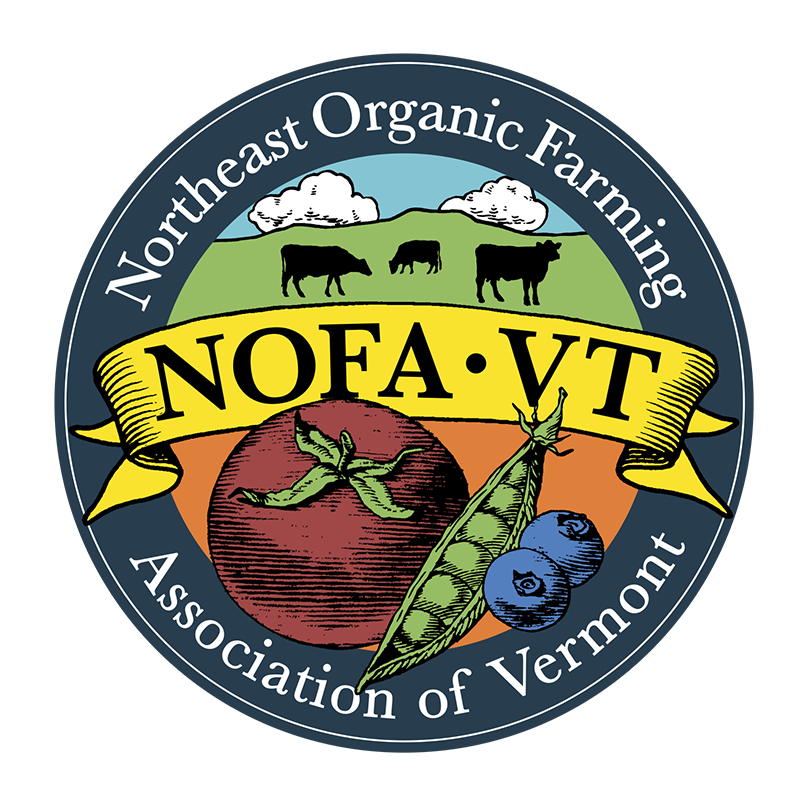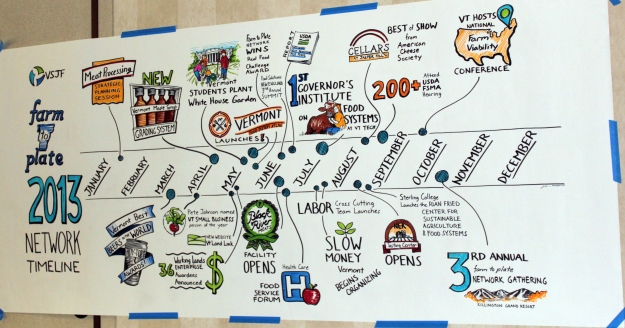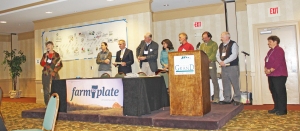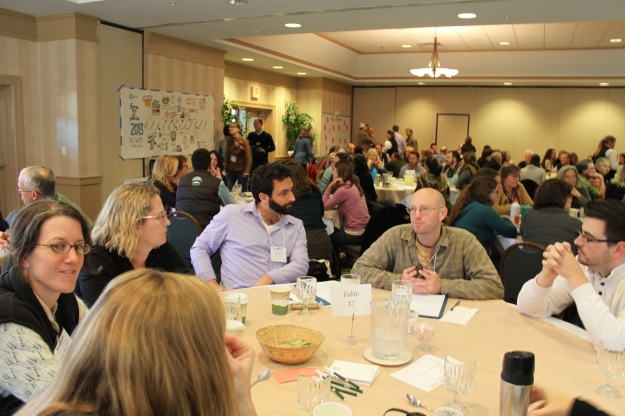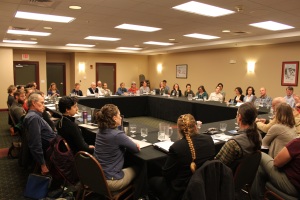 Balancing Act – Farm to Plate attendees “deep dive” into a conversation about affordable food, livable wages, and business viability
Balancing Act – Farm to Plate attendees “deep dive” into a conversation about affordable food, livable wages, and business viabilityCredit: VT Farm to Plate
Designed for Impact—with follow-through
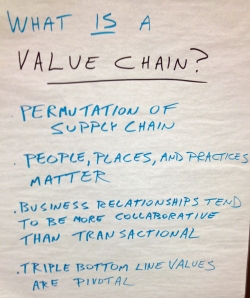 Flipchart from the Connecting the Dots “deep dive” session focused on improving market signals between producers and consumers of local/regional food
Flipchart from the Connecting the Dots “deep dive” session focused on improving market signals between producers and consumers of local/regional food
Credit: Eric DeLuca
Stories are great; I feel good already. But how do you generate (and measure!) impact across a 300+ organization Network? For the last couple years the nonprofit and the foundation worlds have begun giving serious attention to a framework outlined in Stanford Social Innovation Review by Kania and Kramer called Collective Impact. The framework outlines five characteristics of impactful, large-scale change initiatives. Among them is the presence of a backbone organization.
The VT Sustainable Jobs Fund has taken on this role, not only in terms of state statute, but also as a convener and facilitator of the broader Network. The Network, in turn, is intentionally cultivating the other four characteristics, which are:
 Flipchart from the Connecting the Dots “deep dive” session focused on improving market signals between producers and consumers of local/regional food
Flipchart from the Connecting the Dots “deep dive” session focused on improving market signals between producers and consumers of local/regional foodCredit: Eric DeLuca
- Common agenda
- Shared measurement
- Mutually reinforcing activities
- Continuous communication
All Eyes on Vermont
Assuming that all of this engaged planning and coordinated action isn’t too good to be true, it stands to reason that other states have become curious about Vermont’s approach to local/regional food system development. In 2012, the New England states each sent representatives to the VT Farm to Plate Network Gathering to see what the buzz was all about. In 2013 they sent delegations that celebrated interstate collaborations like a new partnership between Black River Meats and Rhode Island family business Daniele, Inc. to produce prosciutto regionally.
It’s easy for fans anywhere (read: food system development leaders and passionate consumers) to track development in the VT Farm to Plate Network through the Vermont Food System Atlas—the “Google” of Vermont’s food system. The Atlas features thousands of resources including farm and producer stories and videos, job listings, data, and a map searchable by people, location, keyword, and category, in addition to all sections of the Farm to Plate Strategic Plan. So stay tuned; remember, this is only year three of a 10-year journey!
 Food+Co-ops is a monthly series curated by NOFA-VT member Eric DeLuca. Eric serves on the Vermont Working Lands Enterprise Board and previously served on the Vermont Agriculture Innovation Center Board, which together have driven over $4M of investment in the Vermont working lands economy since 2010. Eric managed the International Year of Cooperatives for the US through the National Cooperative Business Association. He is currently partnering with UVM Continuing & Distance Education, the Vermont Sustainable Jobs Fund, NOFA-VT and other VT food system leaders to create the first higher ed certificate program focused on food hub management in the country. Eric chairs the VT Farm to Plate Producer and Processor Association Support Task Force and serves on the VT Farm to Plate Financing Crosscutting Team, which is incubating Slow Money VT.
Food+Co-ops is a monthly series curated by NOFA-VT member Eric DeLuca. Eric serves on the Vermont Working Lands Enterprise Board and previously served on the Vermont Agriculture Innovation Center Board, which together have driven over $4M of investment in the Vermont working lands economy since 2010. Eric managed the International Year of Cooperatives for the US through the National Cooperative Business Association. He is currently partnering with UVM Continuing & Distance Education, the Vermont Sustainable Jobs Fund, NOFA-VT and other VT food system leaders to create the first higher ed certificate program focused on food hub management in the country. Eric chairs the VT Farm to Plate Producer and Processor Association Support Task Force and serves on the VT Farm to Plate Financing Crosscutting Team, which is incubating Slow Money VT.
 Food+Co-ops is a monthly series curated by NOFA-VT member Eric DeLuca. Eric serves on the Vermont Working Lands Enterprise Board and previously served on the Vermont Agriculture Innovation Center Board, which together have driven over $4M of investment in the Vermont working lands economy since 2010. Eric managed the International Year of Cooperatives for the US through the National Cooperative Business Association. He is currently partnering with UVM Continuing & Distance Education, the Vermont Sustainable Jobs Fund, NOFA-VT and other VT food system leaders to create the first higher ed certificate program focused on food hub management in the country. Eric chairs the VT Farm to Plate Producer and Processor Association Support Task Force and serves on the VT Farm to Plate Financing Crosscutting Team, which is incubating Slow Money VT.
Food+Co-ops is a monthly series curated by NOFA-VT member Eric DeLuca. Eric serves on the Vermont Working Lands Enterprise Board and previously served on the Vermont Agriculture Innovation Center Board, which together have driven over $4M of investment in the Vermont working lands economy since 2010. Eric managed the International Year of Cooperatives for the US through the National Cooperative Business Association. He is currently partnering with UVM Continuing & Distance Education, the Vermont Sustainable Jobs Fund, NOFA-VT and other VT food system leaders to create the first higher ed certificate program focused on food hub management in the country. Eric chairs the VT Farm to Plate Producer and Processor Association Support Task Force and serves on the VT Farm to Plate Financing Crosscutting Team, which is incubating Slow Money VT.
